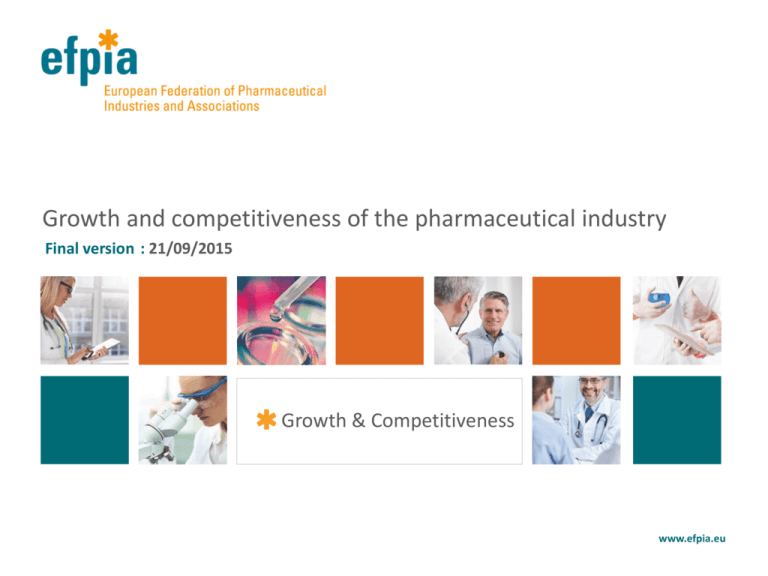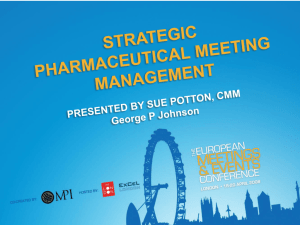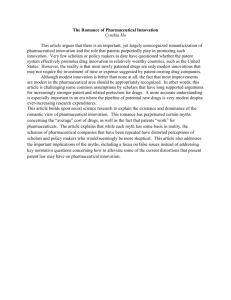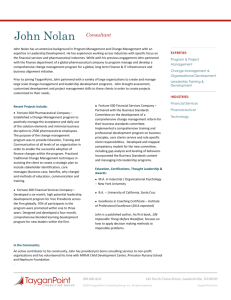Growth & Competitiveness
advertisement

Growth and competitiveness of the pharmaceutical industry Final version : 21/09/2015 Growth & Competitiveness www.efpia.eu Growth and competiveness - rationale The purpose of this document is to address some of the key questions related to the competiveness and growth of the pharmaceutical sector. Why is the pharmaceutical industry a key asset to European competitiveness ? Has the pharmaceutical industry been resilient to the European crisis ? Will the pharmaceutical industry remain a key growth sector in the future and what are the main challenges it needs to tackle ? The document has been divided in three sections which gather a rich and robust collection of evidences aiming at tackling these questions. The objective is to facilitate an evidence-based discussion amongst the different stakeholders including payers, policymakers and regulators. 2 Index Growth and competitiveness-rationale………………………………………..……………………………………..………………………………………………… Index…................................................………………………………………………………………………………………..……………………………………………. Part 1 : Why is the pharmaceutical industry a key asset to European competitiveness ?...........................………….………………… The pharmaceutical industry is the sector with the highest R&D intensity…………………………………………………………………………….. Europe’s high technology economy is still among the world’s most innovative and pharma is supported by a thriving biotech sector……........................................................................................................................................................................................ The pharmaceutical industry is a major source of comparative advantage and growth, and outstrips other innovation-based industries……………………………………………………………………………………………………………..……………………............................................... The research-based pharmaceutical industry is a major high-technology employer in Europe……………………..……………………….. Economic value per employee is higher than comparable industries…………………………………………….…………………......................... Employment in the pharmaceutical sector generates one of the highest returns among comparable industries ……..……………. 2 3 6 7 8 9 10 11 12 3 Index Part 2: Has the pharmaceutical industry been resilient to the economic crisis ?………………………………...…………….…..……………... Europe has maintained its share of clinical trials notably due to positive developments in Eastern Europe…………….................. The pharmaceutical industry continues to drive a positive trade balance for Europe…………………………………..………….……………… Despite the crisis, employment in the pharmaceutical sector has proven to be more resilient than other sectors …................. The pharmaceutical industry is emerging from its R&D productivity crisis with significant innovations…………………………………… Part 3: Will the pharmaceutical industry remain a key growth sector in the future and what are the challenges ahead? …………………………………………………………………………………...……………………...……..……………………… Within healthcare, medicines are amongst the most exciting growth opportunities, currently driven by demand from emerging countries……………………………………………………………………………………………………………….………………………….……….……………. With a high wealth pool, Europe’s ageing population represents the fastest growing consumer segment in Europe….............. Europe plays host to a considerable share of the world’s top academic institutions and centers of clinical academic excellence ……………………………………………………………………………………………………………………………………………………….……….............. On a global basis, Europe still has many of the preconditions for leadership……..……….…………………………….………………............... 13 14 15 16 17 18 19 20 21 22 4 Index However, the pharmaceutical industry will have to address some challenges to maintain its competitiveness......…………….. Europe headquartered companies account for about over one third of all NCEs but face growing competition from “pharmerging” economies……...……………..….................................................................................................................................. Europe is lagging behind the USA as the place where innovators want to launch their products first……….………………............... R&D intensity in the EU is growing more slowly than emerging markets such as China which is rapidly catching up…............... Europe lags behind many other knowledge intensive economies on key indicators……………….……………………………………………….. Bibliography……………………...…………………………………………………………………………………………………………………..……………….....…………. . 23 24 25 26 27 28 5 Part 1: key messages Part 1: Why is the pharmaceutical industry a key asset to European competitiveness ? ✱ The pharmaceutical industry is the sector with the highest R&D intensity ✱ Europe’s high technology economy is still among the world’s most innovative and pharma is supported by a thriving biotech sector ✱ The pharmaceutical industry is a major source of comparative advantage and growth, and outstrips other innovation-based industries ✱ The research-based pharmaceutical industry is a major high-technology employers in Europe ✱ Economic value per employee is higher than comparable industries ✱ Employment in the pharmaceutical sector generates one of the highest returns among comparable industries 6 Part 1: Pharma & Competitiveness The pharmaceutical is the sector with the highest R&D intensity Ranking of industrial sectors by overall R&D intensity (as percentage of net sales, 2013) Pharmaceuticals &Biotechnology 14.4% Software & Computer services 10.4% 8% Technology Hardware and equipment Leisure goods 7.3% Aerospace & Defense 4.6% 4.3% Automobile & Parts 4.3% Electronic & Electrical Equipment 4.2% Health care equipment & services Total 3.2% Industrial engineering 2.8% Chemicals 2.6% 2.2% General industries Banks 2% 1.8% Fixed line telecomunnications Construction and Materials Oil & gas producers 1% 0.3% 0% 5% 10% 15% Note: data relate to the top 2,500 companies with registered offices in the EU (633), Japan (387), the USA (804) and the Rest of the World (676), ranked by total worldwide R&D investment (with R&D investment above €15.5M) Source: The 2014 EU industrial R&D investment scoreboard, European Commission, JRC, DG RTD. 20% 7 Part 1: Pharma & Competitiveness Europe’s high-technology economy is still among the world’s most innovative and pharma is supported by a thriving biotech sector Country shares of high-tech patent applications to the European Patent Office (2009-2011) South Korea 7% Taiwan 1% Rest of the World 6% Country shares of biotechnology patent applications (2009-2011) Australia South Korea 1% 2% European Union 31% Rest of the World 9% Japan 10% EU 37% China 2% Japan 18% China 6% Canada 3% United States 27% USA 36% Source: Eurostat databases on Biotechnology patent applications to the EPO by priority year [pat_ep_nbio] and High-tech patent applications to the EPO by priority year [pat_ep_ntec] (accessed in August 2015). Canada 2% 8 Part 1: Pharma & Competitiveness The pharmaceutical industry is a major source of comparative advantage and growth and outstrips other innovation-based industries Revealed comparative advantage for different industries Relative trade balance of European pharma & other industries Relative trade (net export/total trade volume) +47% -24% +8% -12% +14% The index compares EU exports in one sector (as a percentage of the total EU manufacturing exports) with the same sector’s share from a group of reference countries. RCA values superior to 1 mean that a given industry performs better than its competitors (the reference group) while values below 1 indicate a comparative disadvantage. Source: European Commission: European Competitiveness Report 2014 (2014) 9 Part 1: Pharma & Competitiveness The research-based pharmaceutical industry is a major high-technology employer in Europe Employment in the pharmaceutical industry in EU (1990-2014) +41% 800 000 700 000 1990 2014 Total Employment 600 000 500 000 400 000 +52% 300 000 200 000 100 000 0 Total employment Employment in R&D Note: These statistics are based on official estimates reported by EFPIA member associations. Data includes Turkey (since 2011), Croatia and Lithuania (since 2010), Bulgaria, Estonia and Hungary (since 2009), Czech Republic (since 2008), Cyprus (since 2007), Latvia, Romania and Slovakia (since 2005), Malta, Poland, and Slovenia (since 2004). Source: EFPIA: Pharmaceutical industry in figures (2015, 2013) 10 Part 1: Pharma & Competitiveness Economic value added per employee in the pharmaceutical sector is higher than in comparable industries Gross value added per employee (2010-2012), 1000 euros 180,00 159 160,00 154 159 140,00 120,00 97 100,00 97 food sector 93 chemicals pharmaceuticals 80,00 60 60,00 69 66 60 44 44 60 66 electrical equipment motor vehicules and semi trailer 44 40,00 20,00 ,00 2010 2011 Note: Gross Value Added is defined as the difference between Production and Intermediate inputs. Value added comprises Labour costs (compensation of employees), Consumption of fixed capital, taxes less subsidies (the nature of which depends on the valuation used ) and Net operating surplus and mixed income Source: Eurostat database on employment accessed in March 2015 2012 11 Part 1: Pharma & Competitiveness Employment within the pharmaceutical sector generates one of the highest returns among comparable industries Gross value added per employee Turnover generated per employee Value added/employee (1000 EUR) 0 50 100 Pharmaceuticals 150 154 Chemicals and chemical products 93 Turnover generated per employee (1 000 EUR) 200 0 Machinery and equipment 67 Motor vehicles, trailers and semi-… Motor vehicles, trailers and semi-… 66 Computer, electronic and optical… Computer, electronic and optical… 66 Food products Basic metals 59 Electrical equipment Textiles Furniture Wearing apparel 38 32 21 Source: Eurostat (online data code: sbs_na_ind_r2): 2012 figures (accessed in March 2015) 500 416 370 370 250 Paper and paper products 60 44 400 470 Basic metals Electrical equipment Food products 300 Pharmaceuticals 66 55 200 Chemicals and chemical products Paper and paper products Repair and installation of machinery 100 269 223 161 Machinery and equipment 129 Repair and installation of machinery 126 Textiles 120 Furniture Wearing apparel 93 69 12 Part 2: key messages Part 2: Has the pharmaceutical industry been resilient to the economic crisis ? The pharmaceutical has shown resiliency to the crisis Europe has maintained its share of clinical trials notably due to positive developments in Eastern Europe The pharmaceutical industry continues to drive a positive trade balance for Europe Employment in the pharmaceutical sector has proven to be more resilient than other sectors The pharmaceutical industry is emerging from its R&D productivity crisis with significant innovations 13 Part 2: resiliency to the crisis Europe has maintained its share of clinical trials notably due to positive developments in Eastern Europe Investigator sites for clinical trials (2005-2011) Number of investigator sites involved in pivotal clinical trials submitted in Marketing Authorisation Applications to the Agency per region and year Number of investigator sites 55% 54% 50% 45% 40% 35% 35% 30% 25% 20% 15% 10% 11% 5% 0% 2005 2006 EU/EEA/EFTA 37% 35% 28% 2007 2008 North America 2009 2010 2011 Number of investigator sites 55% 50% 45% 40% 35% 30% 30% 25% 20% 15% 10% 4% 5% 0% 2005 2006 Rest of World Note: EU-15 includes the member states of the European Union prior to the accession of the ten new countries on 1 May 2004, plus EEA countries. EU-10 includes the 2004 accession countries Source: EMA 2013 24% 9% 2007 2008 EU-15 + EEA 2009 2010 2011 EU-10 14 Part 2: resiliency to the crisis The pharmaceutical industry continues to drive a positive trade balance for Europe EU-28 Trade balance for high technology sectors in million (2014) † Trade Balance for Europe (2000-2014)* EUR mn 350,000 300,000 316,500 305,133 276,357 250,000 220,000 200,000 150,000 100,000 199,131 90,935 125,301 50,000 0 216,928 22,094 71,533 74,891 78,000 -50,000 -100,000 -68,841 -150,000 -204,824 -200,000 -250,000 2000 2010 Production Exports -230,242 2013 EUR mn 60 000 50 000 40 000 30 000 20 000 10 000 0 -10 000 -20 000 -30 000 -40 000 -50 000 -238,500 2014(e) Imports Trade balance Note: the graph in the left hand side was based on EfpIA member associations (official figures) - (e): EfpIA estimate; Eurostat (Eu-28 trade data 1995-2013) Source: *EFPIA , The Pharmaceutical industry in figures 2015 (2015), †Eurostat COMEXT database, April 2015. 55,337 33,611 18,135 2,980 Trade balance -45,320 -44,497 Pharmaceutical products Power generating machinery and equipment Office machines and computers Telecommunication, sound, TV, video Electrical machinery Professional, scientific, controlling material 15 Part 2: resiliency to the crisis Despite the crisis, employment in the pharmaceutical industry has proven more resilient than many other sectors Percentage change in employment in selected industries (2008-2012) 5% 1.43% 1.04% 1.05% 2.40% 0.66% 0% -0.50% -5% -1.48% -1.92% -4.34% -7.13% -10% -6.76% -5.20% -10.61% -15% -20% -22.01% -25% Food industry Textile Pharmaceutical products percentage change between 2008 and 2012 Computer, electronics and optical products Electrical equipment Machinery and equipment Motor vehicules, trailers and semi trailers pencentage change in employment between 2011 and 2012 Note: the graph measures change in employment for the EU27 (2008-2012) and for the EU28 (2011-12). The chemical industry could not be included in the graph because of the absence of statistics for the year 2012. Source: Eurostat database on employment by NACE2 sectors. 16 Part 2: resiliency to the crisis The pharmaceutical industry is emerging from its “R&D productivity crisis” with significant innovations Number of New Therapy Drugs approved and Sales (2004-2014) 60 60 53 50 39 40 40 36 34 32 28 30 27 29 31 28 30 24 20 20 10 10 0 51 24 38 25 13 22 29 37 35 53 48 2004 2005 2006 2007 2008 2009 2010 2011 2012 2013 2014 Sales Source: Asher, M. (2015). 2014 FDA drug approvals. Nature reviews drug discovery, 14, pp. 77-81. Number of NTD approvals Total peak sales (US$ billions) 50 0 New Therapy Drugs 17 Part 3: key messages Part 3: Will the pharmaceutical industry remain a key growth sector in the future and what are the challenges ahead? The pharmaceutical industry will remain a key growth sector in the future Within healthcare, medicines are among the most exciting growth opportunities, currently driven by demand from emerging markets With a high wealth pool, Europe’s ageing population represents the fastest growing consumer segment in Europe Europe plays host to a considerable share of the world’s top academic institutions and centers of clinical academic excellence On a global basis, Europe still has many of the preconditions for leadership in life science strategy But it will have to address several challenges : Europe headquartered companies account for about over one third of all NCEs but face growing competition from “pharmerging” economies Europe is lagging behind the USA as the place where innovators want to launch their products first Europe lags behind many other knowledge intensive economies on key indicators 18 Part 3: the future of pharma & challenges Within healthcare, medicines are among the most exciting growth opportunities, currently driven by demand from emerging markets Annual projected pharmaceuticals sales valued at gross ex manufacture price through 2016 Global spending US $bn 1 300 1 200 1 100 1 000 900 800 700 600 500 400 300 200 100 0 +31% Medicine sales expected to reach $1,3trn globally by 2013 290-320 +24% 194 12801310 Building on high growth since 2008, sales are projected to increase by 62% from 2008 to 2018 989 795 2008 2009-2013 Note: Spending in US $ with varying exchange rates. All estimates allow for exchange rate variability. Source: IMS: The global use of medicines through 2018 (2014) 2013 2014-2018 2016 19 Part 3: the future of pharma & challenges With a high wealth pool, Europe’s ageing population represents the fastest growing consumer segment in Europe Global wealth pool of over 60s† +56% 100% 90% 18% 21% 22% 24% 26% 27% 28% 28% 28% 28% 80% 70% 60% 50% 40% 66% 64% 63% 61% 60% 58% 57% 57% 57% 57% 30% 20% 10% 16% 16% 15% 15% 15% 15% 15% 15% 15% 15% Population growth over 60s (CAGR 2011-20 %) Age demographic projections in the EU* 04% 04% 2.32 03% Other emerging countries 2013 2020 2025 2030 2035 2040 2045 2050 2055 2060 0-14 15-64 65 and over Source: * Eurostat; † ERS International Macroeconomic Data Set (2012); †United Nations: Department of Economic and Social Affairs (2011) 4.16 0.49 03% United States 02% 02% Japan 1.72 01% 4.63 Western Europe 01% 00% - 0% BRIC 10000,0 20000,0 30000,0 40000,0 50000,0 60000,0 GDP per capita in 2020 (USD) Bubble size pool represents wealth among over 60s ($trn) 20 Part 3: the future of pharma & challenges Europe plays host to a considerable share of the world’s top academic institutions and centres of clinical academic excellence Regional shares of the world’s top higher education institutions (2014) 100% 90% 80% 70% 60% 50% 40% 30% 20% 10% 0% 4% 13% 5% 4% 5% 4% 52% 39% 4% 5% 5% 14% 17% 18% 6% 6% 31% 29% 6% 35% 35% 40% 41% 40% 41% Top 100 Top 200 Top 300 Top 400 Top 500 Europe United States Rest of North America Source: Shanghai Ranking – Academic Ranking of World’s Universities (2014). Accessed in 2015 Asia Shares of the world’s top 100 clinical and pharmaceutical academic institutions Rest of World 13% Europe 35% United States 52% Oceania 21 Part 3: the future of pharma & challenges On a global basis, Europe still has many of the preconditions for leadership Country comparison on patent applications and higher education institutions Regional shares of the world’s top higher education institutions (2014) 100% 4% 5% 4% 4% 13% 5% 4% 14% 6% 5% 17% 6% 18% 6% 52% 39% 35% 31% 29% 35% 40% 41% 40% 41% Top 100 Top 200 Top 300 Top 400 Top 500 80% 60% 5% 40% 20% 0% Europe United States Rest of North America Asia Oceania Shares of the world’s top hundred clinical and pharmaceutical academic institutions (2014) 13% 35% Source: Eurostat: Various databases (accessed in 2015); Shanghai Ranking: Academic Ranking of World’s Universities (2014); 52% United States 52% Europe 35% Rest of World 13% 22 Part 3: the future of pharma & challenges While the pharmaceutical industry will remain an important sector for Europe, it still needs to address some challenges to maintain its competitiveness Europe headquartered companies account for about over one third of all NCEs but face growing competition from “pharmerging” economies Europe is still consistently lagging behind the US as the place where innovators want to launch their products first EU R&D intensity is growing more slowly than emerging markets such as China which is rapidly catching up Europe lags behind many other knowledge intensive economies on key indicators 23 Part 3: the future of pharma & challenges Europe headquartered companies account for about over one third of all NCEs but face growing competition from “pharmerging” economies New Chemical Entities discovered (100%) Number of new chemical or biological entities (1995-2014)* 100% 90% 80% 70% 60% 50% 40% 30% 20% 10% 0% Number of New Molecular Entities (20092014)† 70 43% 2% 17% 35% 36% 34% 60 6% 8% 14% 50 15% 12% 13% 40 45% 43% 37% 61 39% 30 47 39 35 33 25 20 1995-1999 2000-2004 USA Japan 2005-2009 Others 2010-2014 Europe Between 2010 and 2014, companies headquartered in European countries were responsible for 34% of the New Chemical Entities (NCEs) discovered 10 0 *Note: Percentages might not add due to rounding Source: *EFPIA’ calculation based on the pharmaceutical Industry in Figures (2015), †SCRIP - EFPIA calculations (according to nationality of mother company) 2009 2010 2011 2012 2013 2014 24 Part 3: the future of pharma & challenges Europe is consistently lagging behind the US as the place where innovators want to launch their products first Launches of new active substance by region, 2001 - 2011 70% 66% Launches of new active substance 60% 50% 40% 30% 33% 20% 30% 23% 21% 16% 13% 10% 0% 2001 28% 2002 31% 34% 2003 13% 12% 9% 12% 2004 2005 US Europe 2006 Japan 2007 2008 2009 2010 2011 Rest of the World Note: the graph only includes entirely novel products that were first introduced in any worldwide market during 2010 – as such it includes new chemical entities and biologics but excludes novel formulations or combination products. To be included in this analysis, the products also need to be actively launched on the market, not just approved for sale. Source: Parexel R&D Statistical Sourcebook 2012/2013 25 Part 3: the future of pharma & challenges R&D intensity in the EU is growing more slowly than emerging markets such as China which is rapidly catching up R&D intensity - 2004 vs. 2011† Pharmaceutical R&D Expenditure – Annual growth rate (%)* +8% 12 10 8 6 4,8 Europe 5,2 USA 3,8 4 3,4 2,4 2 0 2000-2004 2005-2009 2010-2014 Note: R&D intensity is defined as Gross Domestic Expenditure on R&D (GERD) as a percentage of Gross Domestic Product (GDP). Source: *EFPIA: Pharmaceutical industry in figures - key data (2015); †Data from Eurostat, accessed in 2015. R&D intensity (GERD as a% of GDP), 2004 vs. 2011 9,9 3.1% 3,0% +50% 2.8% +12% 2.5% 2,5% 1.8% 2,0% 1,5% 3.4% +11% 3,5% 1.8% 2% 1.2% 1,0% 0,5% 0,0% CHN EU28 2004 USA JPN 2011 China’s overall R&D intensity has grown 85% in the last 7 years and is nearly the same as EU’s now 26 Part 3: the future of pharma & challenges Europe lags behind many other knowledge intensive economies on key indicators Europe’s relative performance on key innovation competitiveness indicators Changes in scores on relative competitiveness indicators % difference in performance % change in performance -1,50 -1,00 -0,50 0,00 0,50 1,00 Doctoral graduates Tertiary education International co-publications Most cited publications Public sector R&D expenditure Business sector R&D expenditure Public-private co-publications PCT patents PCT patents for societal change Trade balance Knowledge-intensive services expenditure License and patent revenues United States -5,0 ,0 5,0 0,02 -0,36 0,49 0,63 0,30 -0,37 0,32 -0,36 -0,02 0,01 0,41 0,58 -0,19 0,59 0,01 -0,10 -0,30 0,71 0,88 0,01 0,17 0,16 Japan 0,94 Doctoral graduates Tertiary education International co-publications Most cited publications Public sector R&D expenditure Business sector R&D expenditure Public-private co-publications PCT patents PCT patents for societal change Trade balance Knowledge-intensive services expenditure License and patent revenues ,20 -,30 10,0 15,0 1,50 1,10 -2,30 -3,50 -1,50 -1,90 -,30 -1,60 -,50 -,10 -1,20 -1,60 -1,20 6,40 -3,10 4,0 -,80 -1,80 ,60 ,40 -4,90 -3,70 United States Note: A country has a performance lead over the EU27 if the relative score for the indicator is above 0 and a performance gap with the EU27 if the relative score is below 0. Relative annual growth as compared to that of the EU27 over a 5-year period. Source: European Commission: Innovation Union Scoreboard 2014 (Accessed in March 2015). Japan 27 Growth & Competitiveness 1/9 Sources Asher, M. (2015). 2014 FDA drug approvals, Nature review drug discovery, 14, pp. 77-81. Cambridge Econometrics MDM revisions 7146 (2012) Daemmrich, A. (2009) Where is the pharmacy to the world ? International Regulatory Variation and Pharmaceutical Industry Location, Milken Institute. ECORYS Research and Consulting Competitiveness of the EU Market and Industry for Pharmaceuticals Volume II: Markets, Innovation & Regulation (Released December 2009) http://ec.europa.eu/enterprise/sectors/healthcare/files/docs/vol_2_markets_innovation_regulation_en.pdf (accessed April 2013) EFPIA The Pharmaceutical Industry in Figures – Key data 2014. http://www.efpia.eu/uploads/Figures_2014_Final.pdf (accessed March 2015) 28 Growth & Competitiveness 2/9 Sources EFPIA The Pharmaceutical Industry in Figures – Key data 2015 http://www.efpia.eu/mediaroom/271/21/The-Pharmaceutical-Industry-in-figures-Edition-2015 European Commission The 2014 EU Industrial R&D Investment scoreboard, European Commission, JRC, DG RTD. Available at: http://iri.jrc.ec.europa.eu/scoreboard14.html European Commission European competitiveness report 2014 (2014). http://ec.europa.eu/enterprise/policies/industrial-competitiveness/competitiveness-analysis/europeancompetitiveness-report/index_en.htm European Medicines Agency Clinical trials submitted in marketing-authorisation applications to the European Medicines Agency Overview of patient recruitment and the geographical location of investigator sites http://www.ema.europa.eu/docs/en_GB/document_library/Other/2009/12/WC500016819.pdf (accessed April 2015) http://csdd.tufts.edu/files/uploads/tuftscsdd_academic-industry.pdf (accessed April 2013) 29 Growth & Competitiveness 3/9 Sources Eurostat Annual detailed enterprise statistics for industry (NACE Rev. 2, B-E) [sbs_na_ind_r2], last updated March 2015 http://appsso.eurostat.ec.europa.eu/nui/show.do?dataset=sbs_na_ind_r2&lang=en EUROSTAT EPO Worldwide Patent Statistical Database Excel file accessed at http://www.epo.org/about-us/annual-reports-statistics/statistics/filings.html (accessed April 2015) Eurostat Annual detailed enterprise statistics for industry (NACE Rev. 2, B-E) [sbs_na_ind_r2], last updated March 2015 http://appsso.eurostat.ec.europa.eu/nui/show.do?dataset=sbs_na_ind_r2&lang=en EUROSTAT EPO Worldwide Patent Statistical Database Excel file accessed at http://www.epo.org/about-us/annual-reports-statistics/statistics/filings.html (accessed April 2015) 30 Growth & Competitiveness 4/9 Sources European Commission European Commission: Innovation Union Scoreboard 2013 (2013) http://ec.europa.eu/enterprise/policies/innovation/files/ius-2013_en.pdf (accessed April 2013) European Commission European competitiveness report 2014 (2014). http://ec.europa.eu/enterprise/policies/industrial-competitiveness/competitiveness-analysis/europeancompetitiveness-report/index_en.htm European Medicines Agency Clinical trials submitted in marketing-authorisation applications to the European Medicines Agency Overview of patient recruitment and the geographical location of investigator sites http://www.ema.europa.eu/docs/en_GB/document_library/Other/2009/12/WC500016819.pdf (accessed April 2013) http://csdd.tufts.edu/files/uploads/tuftscsdd_academic-industry.pdf (accessed April 2013) Eurostat ESA 95 Supply, Use and Input-Output tables Database (Updated October 2012, data up to 2008) http://epp.eurostat.ec.europa.eu/portal/page/portal/esa95_supply_use_input_tables/data/database (accessed April 2013) 31 Growth & Competitiveness 5/9 Sources Eurostat Science and Technology Database – R&D expenditure http://epp.eurostat.ec.europa.eu/statistics_explained/index.php/R_%26_D_expenditure (accessed March 2015) IMS Institute for Healthcare Informatics The Global Use of Medicines: Outlook Through 2016 (Released July 2012) http://www.imshealth.com/deployedfiles/ims/Global/Content/Insights/IMS%20Institute%20for%20Healthc are%20Informatics/Global%20Use%20of%20Meds%202011/Medicines_Outlook_Through_2016_Report.pdf (accessed April 2015) IMS Institute for Healthcare Informatics The Global Use of Medicines: Outlook Through 2016 (Released July 2012) IMS Institute for Healthcare Informatics The global use of medicines through 2018 (Released November 2014) 32 Growth & Competitiveness 6/9 Sources OECD Health Status Data set http://stats.oecd.org/Index.aspx?DataSetCode=HEALTH_STAT (accessed April 2013) OECD Government budget appropriations or outlays for RD - Science, technology and Patents database https://stats.oecd.org/Index.aspx?DataSetCode=GBAORD_NABS2007 (accessed March 2015) PAREXEL Biopharmaceutical R&D Statistical Sourcebook 2012/2013 (eStats) Hard copy accessed Mar, April, May 2013 Shanghai Rankings Academic Ranking of World Universities 2014 http://www.shanghairanking.com/ (accessed in March 2015) The Economic Intelligence Unit (EIU) Forecast Market Indicators (updated March 2013) http://www.eiu.com/default.aspx (accessed April 2013) 33 Growth & Competitiveness 7/9 Sources World Health Organisation (WHO) World health statistics report 2013 http://www.who.int/gho/publications/world_health_statistics/EN_WHS2013_Full.pdf (accessed April 2013) Word Intellectual Property Organization (WIPO) WIPO Economics & Statistics Series - WIPO IP Facts and Figures 2012 http://www.wipo.int/export/sites/www/freepublications/en/statistics/943/wipo_pub_943_2012.pdf (accessed April 2013) OECD STAN ( Structural Analysis database) – Accessed in 2015. http://www.oecd.org/industry/ind/stanstructuralanalysisdatabase.htm OECD Database on patent by technology – Accessed in 2015. http://stats.oecd.org/Index.aspx?DataSetCode=PATS_IPC 34 Growth & Competitiveness 8/9 Sources PAREXEL Biopharmaceutical R&D Statistical Sourcebook 2012/2013 (eStats) Hard copy accessed Mar, April, May 2013 Shanghai Rankings Academic Ranking of World Universities 2014 http://www.shanghairanking.com/ (accessed in March 2015) SCRIP publication Accessed in 2015 The Economic Intelligence Unit (EIU) Forecast Market Indicators (updated March 2013) http://www.eiu.com/default.aspx (accessed April 2013) United Nations: Department of Economic and Social Affairs Population Division Database http://esa.un.org/unpd/wpp/unpp/panel_population.htm (accessed April 2013) 35 Growth & Competitiveness 9/9 Sources World Health Organisation (WHO) World health statistics report 2013 http://www.who.int/gho/publications/world_health_statistics/EN_WHS2013_Full.pdf (accessed April 2013) Word Intellectual Property Organization (WIPO) WIPO Economics & Statistics Series - WIPO IP Facts and Figures 2012 http://www.wipo.int/export/sites/www/freepublications/en/statistics/943/wipo_pub_943_2012.pdf (accessed April 2013) 36 EFPIA Brussels Office Leopold Plaza Building * Rue du Trône 108 B-1050 Brussels * Belgium Tel: + 32 (0)2 626 25 55 www.efpia.eu * info@efpia.eu








